- You are here:
- FAOL Home >>
- Articles >>
- Reviews >>
- Product Reviews

All our preparation, consideration and decisions regarding our gear come to the test at the moment we begin our first cast. The gear has to perform at the level we demand ... as we expect it to ... as we know it will. That's what this section is all about. Performance and expectation! The products ... rods, reels, lines and the rest of the angler's arsenal ... featured in these articles are evaluated by our staff of anglers. These anglers come from every level of the sport ... novice to expert. Each has a different perspective, and experience level from which they view and evaluate "quality and performance" in the products reviewed. This is good ... it provides you with definite information from the eyes of real anglers fishing their streams, increasing their knowledge and taking this opportunity to share it with you.
AN OUTLAW REVIEW
Please note that this article is not a product endorsement. I hope you can use the information here to know a bit more about inflatable pontoon drift boats.
The quick and dirty
I am very happy with the pontoon craft I am using. It is manoeuvrable, stable and light enough to portage to the river’s edge. It provides a stable casting platform for 2 anglers and is designed to be piloted by one oarsman. I can shoot rapids right up to class IV-V or spend an entire day comfortably seated.
On the down side, it is less transportable than a canoe. The inherent design of a framed pontoon boat means there are lots of places to get tangled up on (foot pegs etc) and if you drop something, it’ll most probably end up in the drink. It is often preferable to beach the boat to land a big fish.
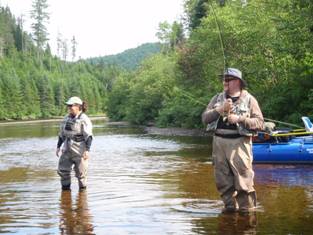
Sylvain working a nice salmon on the 48 pool
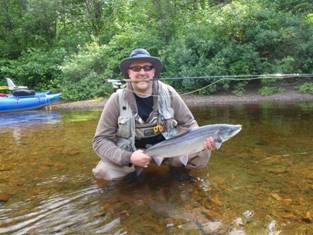
Hey Sylvain! Are we having fun yet ?? !!!
INTRODUCTION
A couple years ago, I carelessly left my 16 ft canoe on the river bank (for 3-4 months) so eventually, someone walked off with it. (I hope they get good use from it and I sure did). Anyhow, I started looking for a canoe, freighter, john boat - something to use here. My choices were soon narrowed down to a couple of options. I could get another canoe in the 16- 17 ft range, a yak or a drift boat.
A canoe was quickly discarded as I often have 2 visitors in the craft at one time. Not stable enough. Further, I’m getting too old to be cramped up for too long. I like to stand up often to stretch my legs and to spot fish. We also cast while standing.
A freighter is an option (that is, a 17-22 ft canoe, square tail canoe for 2, 3, even 4 people. I also put this option aside because of the class II – III rapids we have. I don’t want to have to rely on my passengers to paddle to be able to negotiate even the mildest of white water.
So what I needed was a one man rowing position for multiple (2) passengers. Aha! A drift boat.
There are several wonderful products from the USA as well as from around the world and I had piloted a few different makes and models in BC. Traditional glass or aluminum drift boats come in at around 300 to over 500 pounds. As I don’t usually have organized boat ramps, I need to portage, drag or carry the craft to the water in most situations.
In comes the pontoon drift boat. A friend in Chicoutimi had bought a 2 man pontoon drifter from North Fork Outdoors in 2008. I gave it a good inspection and drilled him with many questions. I was sold on the quality and functionality. In November 2008 I ordered up a three man model. Here’s what I got, my impressions, the minor modifications I did and my (humble) recommendations.
I actually ordered a McKenzie Drifter H2 X3, but since the pontoons were on back order, Dave Scadden had the new Outlaw Outfitter float(s) sent instead:

The McKenzie Drifter with independent pontoons
(Photo – North Fork Outdoors Web site)
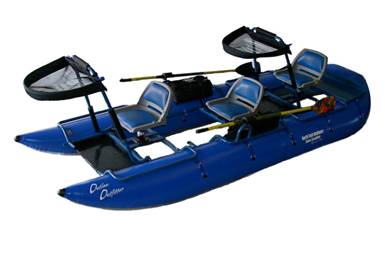
The Outlaw Outfitter
(Photo – North Fork Outdoors Web site)
The shipped weight of the craft was about 145 lbs. Transport took 9 days from Utah to Central Quebec. Shipping was 155$ (USD) plus customs and taxes on my side of the border. UPS takes care of all the paper work and sends you a bill if you are in Canada. In my case, Provincial taxes and broker fees came out to 486$ (CDN). This type of product has no customs fees to pay coming into Canada from the US, but may apply in other countries (for once, NAFTA worked for me).
Because I actually ordered a McKenzie, then Dave upgraded my boat to the newer pontoon(s), the kit I received isn’t exactly like the photo on their web site.
Out of the box, came: (well, 2 boxes)
3 "X-7" aluminum frames,
One piece Uni-Trac pontoon,
2 aluminum oars including sleeves and Oar Rights,
2 oar locks including locking pins,
3 padded seats,
2 sliding standing decks,
2 lean bars,
1 cargo deck
2 side pockets
All the pins and stuff to assemble the craft.
Pump adaptor for Halkey Roberts valves and a patch kit.
I also ordered at the same time:
Extra set of Oar Rights and sleeves;
2 extra side pockets;
1 wheel system;
2 oar holders;
1 double action hand pump.
Everything was there as ordered.
Setup was really a breeze. Because the pontoon is a one piece “U” shaped heat welded PVC construction, (no liner) it sits flat on the floor. Aligning the frame to the pontoon is simple. With 2 independent pontoons, one has to measure, juggle and fiddle with the frame placement. Not a big deal, but with the new Uni-Trac one piece pontoon, it’s a snap. Something to think about if you set up and takedown your craft often.
The instructions state that the set up can take from an hour to a day, depending on how well you read the instructions! Well, as I had already set up many many boats, the initial set up took about 2 hours, including hand pumping the 4 air chambers and fine tuning the strap placements.
The aluminum frame and parts are powder coated and all the welds are top notch. The only screws are those to attach the seats to the frame. All the other connections are made with locking cotter pins. The instructions say to use a bit of paraffin to help the frame slide together. I didn’t do this and everything fit well. I believe that the one piece pontoon helps here as all the parts line up straight. I simply plugged the 3 frame assemblies together and placed it onto the pontoon.
In retrospective, after a season on the river, I am quite comfortable with the ride this model gives.
I needed a drift craft for multiple clients which could run class II to IV rapids without extra help. So far, I’ve been very impressed. Remember, the boat is actually a full 16 feet long from stem to stern. The uplifted (rockered) pontoon makes it very maneuverable. Further, because it has very soft chimes, transitioning across contradictory currents (seams), like crossing into a back eddy, is a breeze. The soft chime of the boat also helps when things go wrong.
Unlike a canoe, if you broach an obstacle, you can get unstuck by leaning INTO the obstacle, let the current push under the craft and you’ll bounce away. I have done this with drift boats too, but it’s not a very good idea as the current can make the upstream side of the hard chimed boat dive and then you’re in a whole world of trouble.
Fully loaded, the boat seems to draft about 3 inches. This is handy for me, because my home waters vary quite a bit over the year. We get conditions of high water flows in the spring and during wet spells. We also get very low flows as the summer draws on.
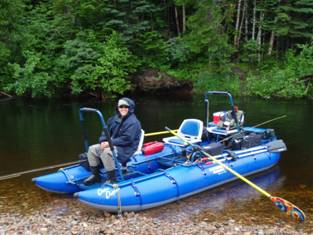
The beauty of this craft is the ease of manoeuvring. As with a drift boat, you row facing forward and use the traditional “backwards” rowing stroke to “back peddle” away from obstacles. Sounds weird, but it’s actually simple, efficient and an excellent way to keep clients and friends over fish for the maximum time possible. (More on this in a future article)
This craft is NOT designed to be rowed UPSTREAM too much though. Many of my friends use their freighters and canoes to travel upstream. I can easily row upstream in mild current. In late June, an upstream wind helped me go +2 miles against the current without effort but I wouldn’t want to do this too often. If I have to move upstream against the current, I can always jump out and hand line the boat from the beach.
I use the option wheel system to get the pontoon from the trailer to the beach. At home I use it to slide down the bank to the river with no problem at all. You can leave the wheel in while on the water. I take it off and strap it to the deck as some of the runs are very shallow here.
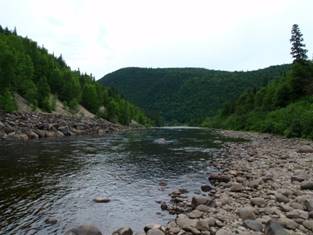
A good example of the kinds of runs we typically drift
It is a BIG, wide boat for the Ste-Marguerite River. The 7 ft stock oars do well here. On bigger water, I prefer 8-9 ft oars. Note: the stock 7 ft oars are just fine for calmly drifting slicks. Some say they don't dig enough. However, if they had bigger stiffer blades, the un-forgiving aluminum shafts would pull pretty hard on your lower back. My friend here uses the 7 ft carbon fiber oars. I also use 8 ft carbon fiber oars and kept the stock oars as spares.
In big water, such a big boat really needs the oars upgrade.
I suppose it’s just human nature, but we all can’t leave well enough alone. Modifying our stuff seems just like a need-to-do habit.
Anchor pulleys
(Addendum - After re-reading the instructions, this is pretty well the same setup that North Fork Outdoors proposes)
The first modification was done to the anchor system. Scadden pontoon boats came with a well thought out pulley system which runs the anchor rope inside the right hand side frame tube. Pulleys are built into the frame to run the rope through, then up to the cargo deck where a third pulley suspends the anchor. When we set up a Scadden boat with 3 stations (that is, 3 frames for 3 passengers), the built in system can’t get the rope to the third pulley. This is mentioned in the instructions, but not on the web site. To correct this, I tried to run 2 more pulleys but found that there were too many 90 degree angles and it was too difficult to lift an appropriate anchor.
To correct this, I ran a new pulley off of the front frame, just in front of my rowing position:
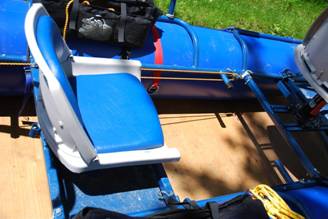
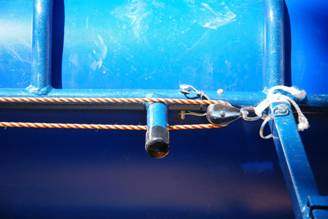
And moved the stock rope cleat to the left side
(my preference, I could have done this right side)
From there, I run the outgoing anchor rope through an eye bolt off a second pulley
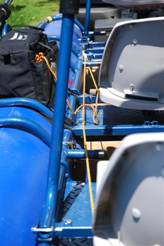
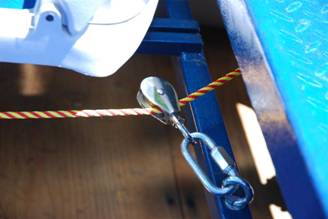
... then up and over the stock pulley mounted under the cargo deck.
Cargo deck
The cargo deck sits on the pontoons and is held in place by 2 cam straps. I set the deck so that the front edge of the deck rests on the rear of the third frame. In order to keep the cargo deck in place, I mounted 2 wooden pickets under the deck about one inch back from the edge.
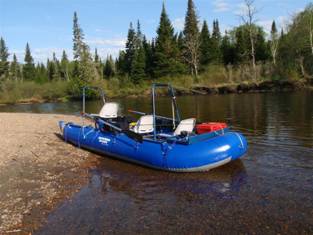
This way, when I cinch down the deck, it sits level and snugly. After more than 12,000 miles on trailer and many drifts down the river, the deck has never moved.
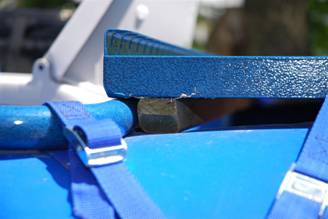
Close up of the wooden picket I secured under the deck using stainless steel screws
Derek at North Fork Outdoors informed me that a bracket has been fabricated to do the same thing. This is probably worth looking into.
Frame modification
The curve on the “U” shaped pontoon seems to make the rear frame dig into the PVC fabric. I was concerned that, over time, the frame could wear into the pontoon. To correct this, I cut off 4 inches of aluminum tubing which was extending back from the seat cross member.
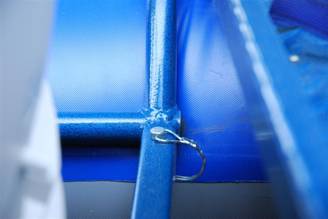
This little bit of tube is used normally to insert a frame aft. Since this is my rear section, I figured I could do it. If I ever need to move the modified frame to replace the front frame, I can still insert the pieces properly.
Just to be sure, I also glued a 3 inch round patch to the pontoon under the rub point.
Strapping
Last minor change I made was the strap which attaches the middle frame to the pontoon. Because the standing decks slide under the seat when not needed, you have to keep the inside frame tube free from obstructions. This is well illustrated in the instruction sheet.
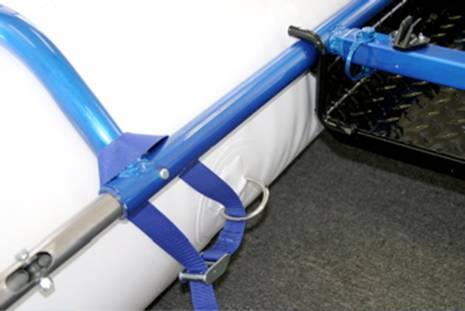
From the NFO web site: Correct positioning for the inside front D-Ring
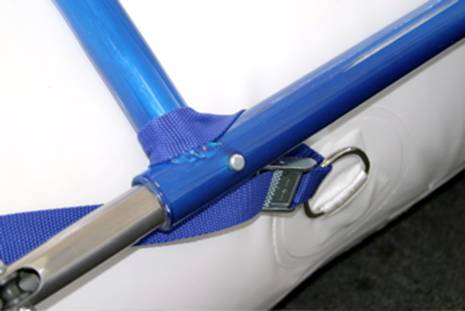
From the NFO web site: The strap pulled tight
I prefer to keep all my straps pulling straight off the D-Rings. In order to get a straight pull off the inside middle D-Ring, I ran a longer cam strap through the D-Ring, up UNDER the inside frame tube and over the outside frame tube.
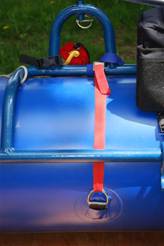
In this way, I got a straight pull off the D-Ring and
I didn’t block the inside frame tube so the sliding standing platform can run properly.
Extras and must haves
Custom trailer
I had a custom trailer built for this craft. I travel a lot, over 600 miles round trip on the highway to get to my favourite spot. The trailer cost about 1,500$ (CDN), single axel with a deck 16ft x 68 inches. I added a jockey box on the tongue to hold cables, locks, accessories and stuff. It was less expensive to have a custom trailer built by a local supplier than an "off the shelf" model big enough for my needs. The quality is also far superior. I had it made by Fabrox Industries in Three Rivers Quebec.
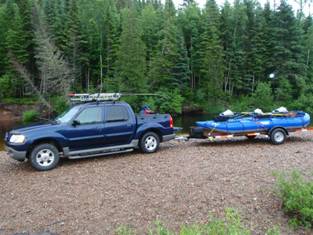
This investment was well worth it. After the 2009 season, I figure I transported the boat over 12,000 miles. The long deck and pole make the trailer easy to backup with and the long wheel base means I can always jack-knife it to turn around in a tight spot.
I also use a wheel lock in conjunction with a hitch lock.
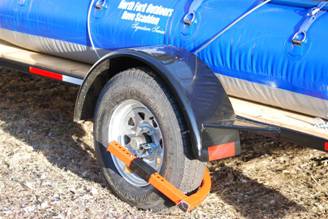
It's not as good as a true Denver Boot, but it'll discourage most casual would-be-thieves.
I added seat risers for all positions. They help make it easier to stand-up and don’t affect the stability of the craft. There are also swivels on the front and rear positions.
I also ordered the carbon fibre oars as they have more “grab”. The stock aluminum oars work fine, but the bigger longer design of the Outfitter with a full load dictates a longer reach and bigger blades. Further, the carbon fibre shafts will help reduce fatigue as the aluminum shafts don’t have the same give as wooden or composite shafts.
When I hit the water, I have a few extras on board:
Anchor
I fabricated a chain anchor out of 14 feet of #100 steel chain. I do NOT drag the chain on the bottom to slow my descent. That’s what oars are for. I also ordered a 15 lb spiked anchor from Dave. Note: When transporting on the trailer, the anchor is secured to a cross member by a carabineer. It would be pretty embarrassing to lose the purchase on the cleat and drag the anchor 50 ft behind the trailer at highway speeds!!
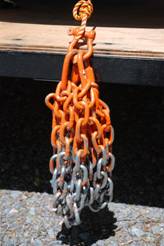
I use a Mountain Equipment Coop throw bag with 50 ft of floating line
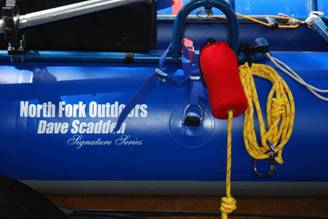
Mooring line
I use the throw rope to moor to logs and when beached. I also use LOCKING carabineers:
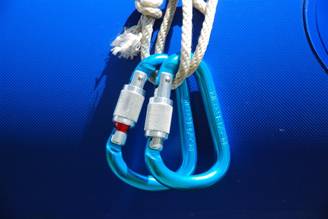
Carabineers in locked and un-locked positions
You NEED locking ‘biners on your throw rope as well as mooring lines.
You must use locking 'biners on throw ropes for white water rescue;
Never rely on an anchor set to hold your boat on the beach.
You must moor to a tree, log or something. Yes, I have seen un-manned canoes and drift boats coming down the river!
On an afternoon drift, I bring a pump, patch kit, extra oar and extra oar lock and some hand tools.
Hand pump
The air will expand or contract as the day changes, if you travel over a pass or if the water is really cold. 3 lbs of pressure is all that's needed. I prefer to keep the pontoon a bit "saggy" then top off the float(s) when the craft is sitting on the water. In this way, it's not getting over inflated in the morning and too loose when it hits the water. You may even take out air at noon when it's really warm, and then top up the pressure for the evening run.
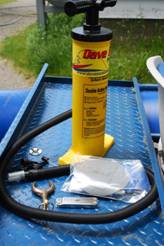
For this same reason, you have to take care when you tie the boat to transport. I use bungees and a combination of cam straps and mountain bike inner tubes. This way, if the pontoon goes soft as conditions change during transport, the tie downs will hold their tension.
Stripping baskets
I don’t have the stripping baskets, so I use William Joseph wading belts with built in stripping baskets:
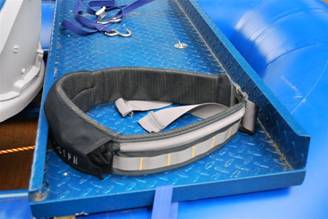

Optional wheel system
The optional wheel system is really handy for such a large boat. The fork fits into the receiver on the centre fame and I use the front foot rests as handles to wheel the loaded boat to the water's edge. I can also use it to help me haul the boat back up the steep bank at home.

Safety equipment
Lastly, I use a Mustang inflatable fishing vest and I have a river knife taped to the seat in front of me.
Not Canadian Coast Guard approved, but a very handy vest:
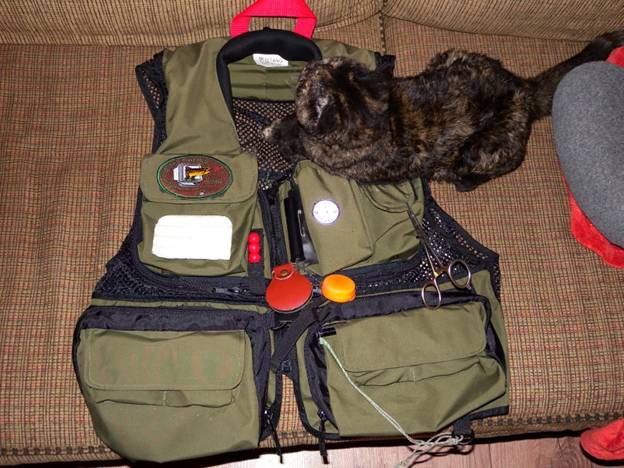
You should wear a PFD in most situations.
The river knife is essential!!!
If the anchor ever gets hung up (and it will eventually), you must cut the rope.
A stuck anchor in even mild current can easily make a boat dive.
A preferred river knife for me is the Gerber Rescue Knife
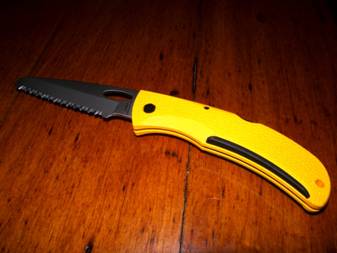
It sells for less than 35$ and cuts rope well.
The blunt tip helps prevent stupid errors while in an inflatable boat!
If you prefer to not have a dedicated rope knife, another one of my favorites is another Gerber product:
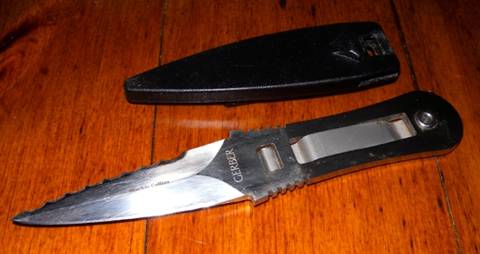
Oar Holders
I use the add-on oar holders. They help transport and are a must when you ship your oars:
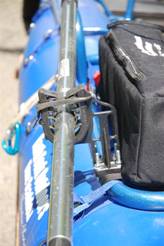
The add-on oar holders simply bolt to the frame and secure the oars neatly.
Also, since I have the carbon fiber oars, which are longer than the stock oars, I moved the oar holders onto the third (rear) frame rail. In this way, the oars sit higher up and out. Just an aesthetics question for me. To avoid having the third person getting tangled up on it, I installed side pockets on the rear station as well.
When transporting the boat, I pull extra cam straps over the oars, just to make sure nothing jumps loose.
Oar-Rights
I had never uses Oar-Rights before, but I'm quite sold on them. They act as a collar and keep the oars in the proper position. You can't feather the oars on the recovery stroke, but, IMHO, this isn't really an issue while drift boating. Some die hards will say one should learn to row without oar-Rights, but this isn't really a consideration when shooting a class III rapid.
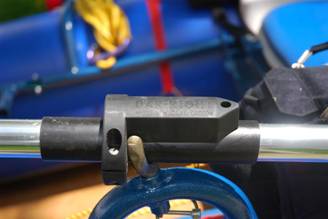
Sleeves and Oar-Rights were included for the stock oars.
Oh, … a note: The boat has NO FLOOR! That’s why stripping baskets are handy (a must). Also, if you drop anything, there is a 99% chance that it will go into the drink. I use a fully waterproof camera:
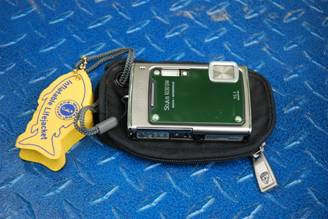
They don’t float! I add a floater to my camera!
The DSLR travels in a "Pelican" case strapped to the cargo deck
Landing net
From a pontoon boat, a landing net is handy.
I use a folding model which also has a telescoping handle. You really need a longer handle or you may find yourself tumbling over board! I prefer the model I have 'cause it is compact and is also used while wading. It attaches to the d-ring on my vest or is tucked into the side pocket beside me.
Closing impressions
I am pleased with the Outlaw Outfitter. It has met and surpassed all my expectations.
It loads out at about 160lbs and I can still easily roll it to the water’s edge using the wheel system.
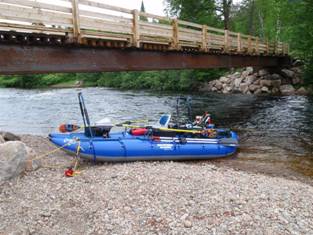
It can turn on a dime and easily avoid obstacles.
I have so far shot the 43a which I believe is a class III as well as the cascade at home …

I’m not certain what the class is, but I had little trouble coming down the cascade in my back yard (alone)
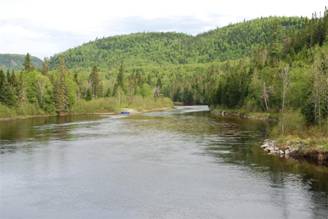
The Outlaw Outfitter on Glass Pool. Ste-Marguerite River - Central Quebec
A quiet drift down 2 miles of runs, we set up over some salmon for the evening.
Would I buy this same boat again if I started all over? In retrospective, one word answer: Yes!!
I did a lot of research and soul searching before deciding to go to a pontoon. Then even more before settling on the Dave Scadden 3 man boat. The PVC heat welded bladderless float(s) was a selling point for me. The lifetime guarantee is nice.
The folks at North Fork Outdoors went to a lot of work getting this package together for me. I am pleased with their knowledge and craftsmanship. If you would like more information, you can Contact me by e-mail or contact North Fork Outdoors through their web site.
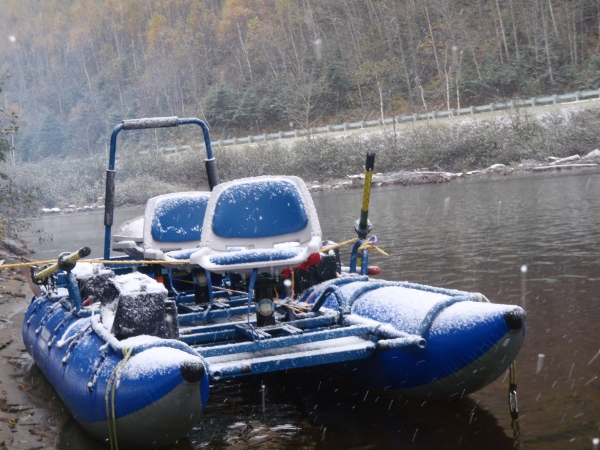
Thanksgiving long weekend - 2009
Christopher Chin, Proulxville, Quebec
Disclaimer:
Aside from selling me a good product, North Fork Outdoors has not paid for nor pre-endorsed this article